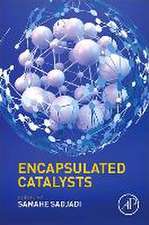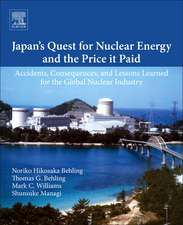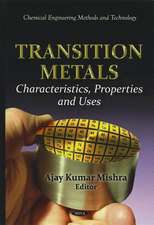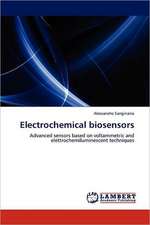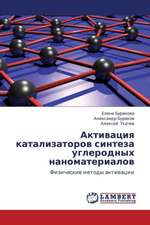Fuel Cells: Current Technology Challenges and Future Research Needs
Autor Noriko Hikosaka Behlingen Limba Engleză Hardback – 29 oct 2012
This volume provides an overview of past and present initiatives to improve and commercialize fuel cell technologies, as well as context and analysis to help potential investors assess current fuel cell commercialization activities and future prospects. Crucially, it also gives top executive policymakers and company presidents detailed policy recommendations on what should be done to successfully commercialize fuel cell technologies.
- Provides a clear and unbiased picture of current fuel cell research programs
- Outlines future research needs
- Offers concrete policy recommendations
Preț: 1054.49 lei
Preț vechi: 1539.35 lei
-31% Nou
Puncte Express: 1582
Preț estimativ în valută:
186.60€ • 218.81$ • 163.87£
186.60€ • 218.81$ • 163.87£
Carte tipărită la comandă
Livrare economică 29 ianuarie-12 februarie 26
Preluare comenzi: 021 569.72.76
Specificații
ISBN-13: 9780444563255
ISBN-10: 0444563253
Pagini: 704
Ilustrații: 30 illustrations (10 in full color)
Dimensiuni: 191 x 235 x 35 mm
Editura: ELSEVIER SCIENCE
ISBN-10: 0444563253
Pagini: 704
Ilustrații: 30 illustrations (10 in full color)
Dimensiuni: 191 x 235 x 35 mm
Editura: ELSEVIER SCIENCE
Public țintă
Students, scientists, and engineers at universities, graduate schools, research institutions, and corporate and government officials who are engaged in fuel cell R&D worldwide. Top government policymakers worldwide, Corporate executives in fuel cell related industries and researchers working at fuel cell related industries worldwide; fuel cell developers, automakers, electric utilities, gas utilities, oil companies, hydrogen manufacturers, electric machinery manufacturers, chemical companies, computer makers, cell phone makers, heavy machinery manufacturers, and related industry associations.Cuprins
PrefaceChapter 1. Introduction1.1. William Grove Invents the Fuel Cell1.2. Fuel Cells: Commercial Success Remains Elusive1.3. The Unfulfilled Promise References
Chapter 2. Fuel Cells and the Challenges Ahead 2.1. What Is A Fuel Cell? 2.1.1. The Unit Cell: A Simple But Formidable Device 2.1.2. Fuel Cell Stacks: Planar or Tubular Designs 2.1.3. Fuel Cell Systems 2.2. Types Of Fuel Cells: Distinct Technologies 2.3. Polymer Electrolyte Membrane Fuel Cells 2.3.1. Principles of Operation and Characteristics 2.3.2. Another Daunting Problem: Electrolyte Performance 2.3.3. Challenges with Transport Applications 2.4. Direct Methanol Fuel Cells 2.4.1. Principles of Operation and Characteristics 2.4.2. Experiencing the Same Problems as PEMFCs And More 2.4.3. Challenges with Portable Applications 2.5. Alkaline Fuel Cells 2.5.1. Principles of Operation and Characteristics 2.5.2. An Early Success, Major Setbacks, Then Redemption, But… 2.6. Phosphoric Acid Fuel Cells 2.6.1. Principles of Operation 2.6.2. The Presumptive "First Generation" Commercial Fuel Cell 2.6.3. Inferior and Expensive 2.7. Molten Carbonate Fuel Cells 2.7.1. Principles of Operation 2.7.2. The Presumptive "Second Generation" Commercial Fuel 2.7.3. Not Durable Enough and Still Expensive 2.8. Solid Oxide Fuel Cells 2.8.1. Principles of Operation and Characteristics 2.8.2. An Early Favorite: High Temperature Tubular Cells 2.8.3. Brief Exploration of High Temperature Planar Cells 2.8.4. The Current Target: Intermediate Temperature Planar Cells, Many Problems Remain2.8.5. Are Alternative Cell Designs Feasible? References
Chapter 3. History of Alkaline Fuel Cells 3.1. Overview 3.2. Francis T. Bacon Builds The First Alkaline Fuel Cell 3.3. AFC Development in the United States 3.3.1. United Technologies Corporation Achieves Spectacular Success with AFCs in Space 3.3.2. Union Carbide Corporation: Vigorous Efforts but No Successes 3.3.3. Allis Chalmers: Sharing the Same Fate as UCC 3.4. AFC Development in Europe: Decades of Work With No Significant Consequence..But Some Field Tests Continue 3.4.1. AFC Development in Germany 3.4.2. AFC Development in France 3.4.3. AFC Development in Belgium: Elenco 3.4.4. AFC Development in Sweden: ASEA 3.4.5. AFC Development in UK: AFC Energy 3.5. AFC Development in Russia: Sustained Effort, But With Little Commercial Success 3.5.1. Kiev Research and Production Association "KVANT" 3.5.2. S.P. Korolev Rocket and Space Corporation RSC "ENERGIA" 3.5.3. Ural Electrochemical Integrated Plant 3.5.4. ZAO Independent Power Technologies 3.5.5. No Commercial Success in the Near Term 3.6. AFC Development in Japan: Limited Activities of No Consequence..But A New Effort Emerges 3.6.1. Fuji Electric 3.6.2. Hitachi 3.6.3. Japan Storage Battery 3.6.4. Sanyo 3.6.5. Panasonic 3.6.6. Daihatsu Motor References
Chapter 4. History of Phosphoric Acid Fuel Cells 4.1. Overview 4.2. PAFC Development in the United States: 25 Years of Government Programs Fail to Produce a Cost-Competitive PAFC System4.2.1. US Army’s PAFC Programs4.2.2. US Air Force PAFC Programs4.2.3. PAFC Programs for Stationary Applications: United Technologies Corporation (UTC) Prevails4.2.3.1. TARGET Program4.2.3.2. GRI-DOE Project4.2.3.3. FCG-1 (Fuel Cell Generator 1) Project4.2.4. Other PAFC Programs in the United States4.2.4.1. Engelhard4.2.4.2. Energy Research Corporation (ERC)4.2.4.3. Westinghouse4.2.5. PAFC Programs for Transport Applications: No Successes4.2.6. US PAFC Subsidy Programs4.2.6.1. US Department of Defense Demonstration Program4.2.6.2. DoD Climate Change Fuel Cell Rebate Program4.2.6.3. Federal and State Tax Credit Programs Implemented4.2.7. A Major New Hope Emerges.But Results in Little Consequence4.3. PAFC Development in Japan4.3.1. Japanese Private-Sector PAFC Activities Begin in the 1960s4.3.1.1. Japanese Utility Companies Engage in Field-Testing of US PAFC Power Plants4.3.1.2. Japanese Electric Machinery Companies Launch PAFC Development4.3.2. Japanese Government Launches PAFC Program in 19814.3.2.1. METI’s Moonlight Project4.3.2.2. Other METI PAFC Programs4.3.3. Government and Private Sector Join Hands in Field Test Program4.3.3.1. METI PAFC Field Test Program 4.3.3.2. Private-Sector Field-Test Activities4.3.4. Japanese Fuel Cell Subsidy Programs: Funding One-Third to Two-Thirds of Acquisition Cost4.3.5. PAFC Power Plants Are Not a Commercial Success4.3.6. Government Evaluates PAFC R&D Program as Inadequate4.4. PAFC Development in Other Countries: Primarily Test-Operating US and Japanese PAFC Power Plants4.4.1. European Countries4.4.2. The Rest of the World4.4.3. Again, No Measurable Commercial SuccessReferences
Chapter 5. History of Molten Carbonate Fuel Cells 5.1. MCFC Effort Starts in the Netherlands in the 1950S5.2. MCFC Development in the United States5.2.1. Early Efforts5.2.1.1. The US Army: Early MCFC Supporter5.2.1.2. The Institute of Gas Technology: Early MCFC Developer5.2.2. The Department of Energy: Initiating MCFC R&D Program in 19755.2.2.1. MCFC Development Program in the 1980s: GE and UTC Emerge as Prime Contractors5.2.2.2. MCFC Demonstration Program in the 1990s: Fuel Cell Energy and M-C Power as Primary Developers5.2.3. Commercial Success Still Uncertain5.3. MCFC Development in Japan5.3.1. Government Plays Dominant Role–Limited Activities in Private Sector5.3.2. The Ministry of Economy, Trade, and Industry Starts MCFC Development Program in 19815.3.2.1. Phase I MCFC Development (1981-1986): Five Companies Participate in 10kW Stack Development5.3.2.2. Phase II MCFC Development (1987-1999): Three Companies Participate in 200 kW Internal Reforming Stack and 1000kW Pilot Plant Development5.3.2.3. Phase III MCFC Development (2000-2004): Only One Company Remains5.3.3. MCFC Commercialization in Japan Hopeless5.4. MCFC Development in Europe5.4.1. The Netherlands Revives Europe’s MCFC Development Effort in 19865.4.1.1. European Union Framework Program Starts Funding Dutch MCFC Efforts in 1987–ECN Takes the Lead5.4.1.2. The Netherlands Ends MCFC Development in 19995.4.2. Italy Starts MCFC R&D also in 1986–Ansaldo Ricerche Takes the Lead5.4.2.1. EU Framework Program Supporting the Italian MCFC Effort in 19875.4.2.2. Ansaldo’s MCFC Commercialization Phase Delayed5.4.3. Germany Starts MCFC Development in 1988–MBB (Currently CFC Solutions) Takes the Lead5.4.3.1. EU Framework Program Begins Supporting German MCFC Effort in 19905.4.3.2. German Government’s MCFC Demonstration Programs Bolsters HotModule Installations5.4.3.3. CFC Solutions Shuts Down its MCFC Business in December 20105.5. MCFC Development in South Korea5.5.1. South Korea Begins MCFC Development in 19935.5.2. South Korea More Interested in Rapid Acquisition of Foreign MCFC Technology for Domestic Economy and Export Growth5.5.3. POSCO’s MCFC Strategy Still Unfolding.Too Early to Predict the OutcomeReferences
Chapter 6. History of Solid Oxide Fuel Cells 6.1. Introduction6.2. US Department of Energy Initiates SOFC R&D Program in 19776.2.1. DOE Taps Westinghouse to be Global Leader of SOFC Technology6.2.1.1. Westinghouse Makes Major Technological Advances in 19956.2.1.2. Siemens Acquires Westinghouse and Launches Ambitious Commercialization Plans (1997-2002)6.2.1.3. Siemens Westinghouse Hits Technical Barriers in the 2000s..Validation of Tubular SOFC Technology Fails6.2.1.4. Siemens Westinghouse Abandons Tubular SOFC Commercialization, Shuts Down Fuel Cell Business, September 30, 20106.2.2. DOE Launches SECA Program in 2001 in Search of New SOFC Technology6.2.2.1. SECA Sets Off Renewal of Global Interest in SOFCs6.2.2.2. SECA Soon Encounters Tough Challenges6.2.2.3. Development of Commercially Viable SOFCs Under SECA Unlikely6.2.3. Meanwhile, Many US Companies Launch SOFC Development Activities6.2.3.1. Acumentrics6.2.3.2. Allied Signal Aerospace6.2.3.3. Bloom Energy6.2.3.4. Ceramatec6.2.3.5. Cummins Power Generation6.2.3.6. Delphi6.2.3.7. FuelCell Energy/Versa Power System6.2.3.8. General Electric6.2.3.9. Protonex6.2.3.10. Rolls Royce Fuel Cell Systems6.2.3.11. Siemens Westinghouse Power Corporation6.2.3.12. SOFCo6.2.3.13. Technology Management, Inc6.2.3.14. UTC Power/Delphi6.2.3.15. Ztek6.2.4. US Global SOFC Leadership Position Has Largely Eroded6.3. Japan Launches SOFC Research in Wake of Oil Crisis6.3.1. METI Begins Modest Funding of Basic SOFC Research in 19746.3.2. METI Launches Long-Term SOFC R&D Programs in 19896.3.2.1. SOFC R&D Program Phase I (1989-1991)6.3.2.2. SOFC R&D Program Phase II (1992-1997)6.3.2.3. SOFC R&D Program Phase II Extension (1998-2000)6.3.2.4. SOFC R&D Program Phase III (2001-2004)6.3.3. MITI Begins Ambitious System Technology Development Program (2004-2007) in 20046.3.3.1. System Development Program (2004-2007)6.3.3.2. Component Technology Development Program (2005-2007)6.3.3.3. The Post-Program Evaluation Report Judges the 2004-2007 SOFC R&D Program to be an Overall Failure6.3.4. SOFC Demonstration Research Program (2007-2010): A New Hope for Near-Term SOFC Commercialization6.3.4.1. Program Helps SOFC Industry Grow6.3.4.2. Program Results Are Mixed6.3.5. METI Institutes "Back-to-Basics" Research Program (2008-2012)6.3.5.1. Program is Subject to Serious Constraints6.3.6. Still Japanese SOFC Developers Press on with Their Commercialization Plans6.3.6.1. Acumentrics Japan6.3.6.2. National Institute of Advanced Industrial Science and Technology6.3.6.3. Central Research Institute of Electric Power Industry6.3.6.4. Fuji Electric6.3.6.5. Fujikura Cable6.3.6.6. Kyocera: The Leading SOFC Player in Japan Today6.3.6.7. Mitsubishi Heavy Industries6.3.6.8. Mitsubishi Materials Corporation/Kansai Electric6.3.6.9. Mitsui Engineering and Shipbuilding6.3.6.10. Murata Manufacturing/Osaka Gas6.3.6.11. NGK Insulators/J-Energy/Sumitomo Precision Products6.3.6.12. NGK Spark Plugs/AIST/Fine Ceramic Research Association/Toho Gas6.3.6.13. JX Nippon Oil & Energy/Kyocera6.3.6.14. Nippon Telegraph and Telephone (NTT)6.3.6.15. Sanyo Electric6.3.6.16. Toho Gas/Sumitomo Precision Products/Nippon Shokubai/Daiichi Kigenso6.3.6.17. Tonen6.3.6.18. TOTO/Hitachi/Kyushu Electric/Nippon Steel6.3.7. Japan’s Initiatives Approach Critical Mass6.4. Europe Restarts SOFC Development in 19866.4.1. Denmark6.4.1.1. Risø and Haldor Topsoe: Developmental Work in Partnership6.4.1.2. Forming a Consortium in 2001 for SOFC Commercialization6.4.1.3. Forming a Topsoe Fuel Cell for SOFC Commercialization in 20046.4.1.4. Topsoe Fuel Cell Achieves a Number of Milestones6.4.1.5. But No discernible commercial Success6.4.2. Finland 6.4.2.1. Wa¨rtsila¨ Starts SOFC Development in 2000 But Soon Chooses to Outsource SOFC Stacks6.4.2.2. Wa¨rtsila¨ Optimistic about Commercialization of WFC20 and WFC50 Units6.4.2.3. But Technology Yet to be Validated6.4.3. Germany6.4.3.1. Asea Brown Boveri (ABB): Started SOFC R&D in 1968, Ended in 19936.4.3.2. BMW: Begins SOFC R&D in Late 1990s, Ends in Late 2000s6.4.3.3. Dornier: Begins SOFC R&D in 1988, Ends in 19956.4.3.4. Forschungszentrum Julich6.4.3.5. H.C. Starck/Staxera/Webasto (Enerday)6.4.3.6. Siemens Efforts: Rise and Fall in 50 years6.4.4. The Netherlands6.4.4.1. ECN Starts SOFC Activities in 1987 6.4.4.2. ECN forms InDEC, a spin-off SOFC Ceramic Component Production Company, in 1999 6.4.4.3. InDEC Acquired by German Company H.C. Starck6.4.5. Switzerland6.4.5.1. HTceramix Starts as a University Spin-Off in 20006.4.5.2. Sulzer/Sulzer Hexis/Hexis6.4.6. United Kingdom6.4.6.1. Alstom: Started SOFC R&D in Mid-1990s, Ended in Early 2000s6.4.6.2. Ceres Power6.4.6.3. Rolls Royce Fuel Cell Systems6.4.7. Europe Lacks Clear SOFC Strategy6.5. Other Countries6.5.1. Australia 6.5.1.1. CSIRO establishes Ceramic Fuel Cells Limited in 19926.5.1.2. CFCL Develops Pre-Commercial Demonstration Units in 2005–Creates Major Interest among Utilities6.5.1.3. CFCL Establishes Large-Scale Manufacturing Facilities and Component Supply Chains in Europe6.5.1.4. CFCL Launches New Commercial Product–2 kW BlueGenPower Plant6.5.1.5. Commercial Success Not Yet Guaranteed6.4.4.1. ECN Starts SOFC Activities in 19876.4.4.2. ECN forms InDEC, a spin-off SOFC Ceramic Component Production Company, in 1999 6.4.4.3. InDEC Acquired by German Company H.C. Starck6.4.5. Switzerland6.4.5.1. HTceramix Starts as a University Spin-Off in 20006.4.5.2. Sulzer/Sulzer Hexis/Hexis6.4.6. United Kingdom6.4.6.1. Alstom: Started SOFC R&D in Mid-1990s, Ended in Early 2000s6.4.6.2. Ceres Power6.4.6.3. Rolls Royce Fuel Cell Systems6.4.7. Europe Lacks Clear SOFC Strategy6.5. Other Countries 6.5.1. Australia 6.5.1.1. CSIRO establishes Ceramic Fuel Cells Limited in 19926.5.1.2. CFCL Develops Pre-Commercial Demonstration Units in 2005–Creates Major Interest among Utilities6.5.1.3. CFCL Establishes Large-Scale Manufacturing Facilities and Component Supply Chains in Europe6.5.1.4. CFCL Launches New Commercial Product–2 kW BlueGen Power Plant6.5.1.5. Commercial Success Not Yet Guaranteed6.5.5. India 6.5.5.1. Central Glass and Ceramic Research Institute6.5.5.2. Too Early to Foretell Future Outcome6.6. Japan Emerges as the Global SOFC Leader; the United States and Europe Follow Behind6.6.1. Japan Promotes Close Public-Private Collaboration, Greater Breadth of Industrial Expertise and Infrastructure6.6.2. The United States Loses Its Edge Through the Slow Erosion of Its Base6.6.3. Europe Is Fragmented, Uncoordinated, and Ineffective6.6.4. But No Country Has a Viable SOFC Product YetReferences
Chapter 7. History of Proton Exchange Membrane Fuel Cells and Direct Methanol Fuel Cells7.1. Introduction 7.2. US National Aeronautics and Space Administration Boosts GE’S PEMFC R&D in the late 1950S 7.2.1. GE PEMFCs Fail Manned Space Mission in the late 1960s 7.2.2. New Nafion Membrane Increases PEMFC Efficiency. But GE Abandons PEMFC Effort in 19847.3. Canadian Government Decides to Foster Domestic PEMFC Capabilities in the Early 1980s 7.3.1. Canada’s Defense Department Commissions Ballard to Advance GE’s PEMFC Technology in 1983 7.3.1.1. Second Contract Makes Marked Advances toward Practical Applications of PEMFCs 7.3.2. Canada’s Energy Department Sponsors Ballard to Develop PEM Fuel Cell Bus in 1990 7.3.3. Ballard Becomes the Global PEMFC Leader 7.3.3.1. Ballard/Daimler-Benz/Ford Fuel Cell Car Alliance Formed in 1997 7.4. A Global Fuel Cell Race Begins 7.4.1. Major Global Automakers and Bus Manufacturers Join the Race 7.4.1.1. Beijing LN Green Power Company (China) 7.4.1.2. Daihatsu 7.4.1.3. Daimler-Benz (DaimlerChrysler) 7.4.1.4. Dalian Institute of Chemical Physics (DCIP) (China) 7.4.1.5. EvoBus 7.4.1.6. Fiat 7.4.1.7. Ford7.4.1.8. General Motors 7.4.1.9. Gillig 7.4.1.10. Hino 7.4.1.11. Honda 7.4.1.12. Hyundai 7.4.1.13. Irisbus 7.4.1.14. Man Nutzfahrzeuge (MAN Trucks and Bus) 7.4.1.15. Mazda 7.4.1.16. Mitsubishi Motors 7.4.1.17. NEOPLAN 7.4.1.18. New Flyer Industries 7.4.1.19. Nissan7.4.1.20. Nova Bus 7.4.1.21. PSA Peugeot Citroen 7.4.1.22. Renault 7.4.1.23. Scania 7.4.1.24. Suzuki 7.4.1.25. Thor Industries (ThunderPower) 7.4.1.26. Toyota 7.4.1.27. Tongji University (China) 7.4.1.28. Tsinghua University (China) 7.4.1.29. Van Hool 7.4.1.30. Volkswagen 7.4.2. Many Governments Join the Race to Boost Domestic PEMFC Capabilities 7.4.2.1. Japanese Government Begins Modest R&D Investment in 1992 7.4.2.2. US Government Launches Ambitious Fuel Cell Car and Hydrogen Technology Initiatives in 2002 7.4.2.3. Europe Recognizes Global Fuel Cell Challenge in Late 1990s 7.4.2.4. Other Governments 7.5. The Global Fuel Cell Race So Far Fails to Attain Commercial Success 7.5.1. Transportation Applications 7.5.1.1. Passenger Cars 7.5.1.2. Buses 7.5.1.3. Material Handling Vehicles 7.5.1.4. Other Transport Applications (Scooters, Bikes, Trains, Marine Vessels, and Aircraft)…Perhaps No Near-Term Commercial Success 7.5.2. Stationary Applications Shore up Only Two Notable Markets 7.5.2.1. Small Residential Combined Heat and Power Market in Japan Sustained by Government Subsidies 7.5.2.2. Backup Power (UPS/Emergency Power/Remote Power) Market in the United States… With Potential Success in the Near Term7.5.3. Portable Fuel Cell Applications 7.5.3.1. Consumer Electronic Devices Not Yet Commercially Viable 7.5.3.2. Major Success in Toys and Educational Systems...and Beyond 7.5.3.3. SFC Energy: The Global Leader in Portable Auxiliary Power Unit Applications 7.5.4. Conclusion: An Unexpected and Disconcerting Trend 7.5.4.1. Perhaps Current Fuel Cell Technology Is Only Adequate for Niche Market Applications 7.5.4.2. And Not Mature Enough for Primary Market Applications 7.5.4.3. Incremental Improvement Unlikely to Deliver Near-Term Commercial Success in Primary MarketsReferences
Chapter 8. Strengths and Weaknesses of Major Government Fuel Cell R&D Programs: Europe, Japan, and the United States 8.1. Fuel Cell R&D Expenditure: Japan Invests The Most 8.1.1. Government R&D Funding: Japan Outspends the United States and Europe 8.1.2. Private-Sector R&D Investment: Japanese Government and Industry Together Outspend the United States by a Factor of Two; European Government and Industry Together Outspend the United States by 50 percent 8.2. Consistency In Policy And Programs: Japan Is The Most Constant And Stable 8.3. Soundness Of Program Evaluation: US Evaluation Is The Least Valuable 8.4. Resilience In Industry: Europe Is The Least Sturdy 8.4.1. Alkaline Fuel Cells 8.4.2. Phosphoric Acid Fuel Cells 8.4.3. Molten Carbonate Fuel Cells 8.4.4. Solid Oxide Fuel Cells 8.4.5. Proton Exchange Membrane Fuel Cells 8.5. Fuel Cell Patenting Activity 8.5.1. Japan Grants the Largest Number of Fuel Cell Patents in 2010 8.5.2. Japanese Corporations Expand Dominance in Fuel Cell Patent Activity During the Past Decade 8.6. The Global Fuel Cell Leader Today References
Chapter 9. Policy Recommendations 9.1. Difficulties Of Perfecting Fuel Cell Technology Never Understood9.2. Until Recently, Science And Physics Too Immature For Fundamental Understanding Of Fuel Cell 9.3. Fuel Cell Knowledge Requires Multiple Scientific Disciplines…But Few Institutions Have Interdisciplinary Research Capabilities 9.3.1. The United States Starts a Small Interdisciplinary PEMFC Basic Research Center in 2007 9.3.2. Japan Launches an Interdisciplinary PEMFC Basic Research Project in 2010 9.3.3. Small Budgets, Short Deadlines, and Overarching Goal of Commercialization Might Inhibit Basic Research 9.4. Fuel Cell Development Requires Three Levels Of Research: Basic Research Supported By Applied Research And Product Development 9.4.1. Forschungszentrum Julich Assigned to Lead EU FP6 Real-SOFC Project to Address Degradation in 2004 9.4.2. AIST Assigned to Lead SOFC Basic Research Project to Address Degradation in 2008 9.4.3. .But Basic Research Limited by Serious Constraints 9.5. Fuel Cell Too Valuable To Abandon: Go Back To Basics Now 9.6. Learning from Past Experience To Plan Future Course Of Action 9.6.1. Past Spending 9.6.2. An Exemplar in History: The Manhattan Project 9.6.2.1. Preceded by Nobel Prize-Class Nuclear Fission Basic Research in the 1930s 9.6.2.2. The Manhattan Project–An Applied Research and Development Project–Began in 1939 9.7. Policy Recommendations: Implementation Of The National Fuel Cell Development Project 9.7.1. Basic Research: A Central and Vital Mission 9.7.2. Budget and Research Period: $2 Billion a Year for 5 Years 9.7.3. Giving a New Mission to National and Industry R&D Labs 9.7.3.1. Appointing Selected National Laboratories, Universities, and Their Research Cadre for Basic Research: At least 2000 Top-Notch Scientists and Physicists from All Related Disciplines 9.7.3.2. Enlisting Fuel Cell Industry for Applied Research and Product Development 9.7.4. The NFCDP as Top National Energy Security Priority 9.7.5. Three Possible National Options for the NFCDP Project Implementation 9.7.5.1. German Option 9.7.5.2. Japanese Option9.7.5.3. US Option 9.7.6. The Outlook–Japan Will Likely Emerge as First Global Fuel Cell Market Leader for the Next Decade–But the World Will Be the Ultimate Winner References
Chapter 2. Fuel Cells and the Challenges Ahead 2.1. What Is A Fuel Cell? 2.1.1. The Unit Cell: A Simple But Formidable Device 2.1.2. Fuel Cell Stacks: Planar or Tubular Designs 2.1.3. Fuel Cell Systems 2.2. Types Of Fuel Cells: Distinct Technologies 2.3. Polymer Electrolyte Membrane Fuel Cells 2.3.1. Principles of Operation and Characteristics 2.3.2. Another Daunting Problem: Electrolyte Performance 2.3.3. Challenges with Transport Applications 2.4. Direct Methanol Fuel Cells 2.4.1. Principles of Operation and Characteristics 2.4.2. Experiencing the Same Problems as PEMFCs And More 2.4.3. Challenges with Portable Applications 2.5. Alkaline Fuel Cells 2.5.1. Principles of Operation and Characteristics 2.5.2. An Early Success, Major Setbacks, Then Redemption, But… 2.6. Phosphoric Acid Fuel Cells 2.6.1. Principles of Operation 2.6.2. The Presumptive "First Generation" Commercial Fuel Cell 2.6.3. Inferior and Expensive 2.7. Molten Carbonate Fuel Cells 2.7.1. Principles of Operation 2.7.2. The Presumptive "Second Generation" Commercial Fuel 2.7.3. Not Durable Enough and Still Expensive 2.8. Solid Oxide Fuel Cells 2.8.1. Principles of Operation and Characteristics 2.8.2. An Early Favorite: High Temperature Tubular Cells 2.8.3. Brief Exploration of High Temperature Planar Cells 2.8.4. The Current Target: Intermediate Temperature Planar Cells, Many Problems Remain2.8.5. Are Alternative Cell Designs Feasible? References
Chapter 3. History of Alkaline Fuel Cells 3.1. Overview 3.2. Francis T. Bacon Builds The First Alkaline Fuel Cell 3.3. AFC Development in the United States 3.3.1. United Technologies Corporation Achieves Spectacular Success with AFCs in Space 3.3.2. Union Carbide Corporation: Vigorous Efforts but No Successes 3.3.3. Allis Chalmers: Sharing the Same Fate as UCC 3.4. AFC Development in Europe: Decades of Work With No Significant Consequence..But Some Field Tests Continue 3.4.1. AFC Development in Germany 3.4.2. AFC Development in France 3.4.3. AFC Development in Belgium: Elenco 3.4.4. AFC Development in Sweden: ASEA 3.4.5. AFC Development in UK: AFC Energy 3.5. AFC Development in Russia: Sustained Effort, But With Little Commercial Success 3.5.1. Kiev Research and Production Association "KVANT" 3.5.2. S.P. Korolev Rocket and Space Corporation RSC "ENERGIA" 3.5.3. Ural Electrochemical Integrated Plant 3.5.4. ZAO Independent Power Technologies 3.5.5. No Commercial Success in the Near Term 3.6. AFC Development in Japan: Limited Activities of No Consequence..But A New Effort Emerges 3.6.1. Fuji Electric 3.6.2. Hitachi 3.6.3. Japan Storage Battery 3.6.4. Sanyo 3.6.5. Panasonic 3.6.6. Daihatsu Motor References
Chapter 4. History of Phosphoric Acid Fuel Cells 4.1. Overview 4.2. PAFC Development in the United States: 25 Years of Government Programs Fail to Produce a Cost-Competitive PAFC System4.2.1. US Army’s PAFC Programs4.2.2. US Air Force PAFC Programs4.2.3. PAFC Programs for Stationary Applications: United Technologies Corporation (UTC) Prevails4.2.3.1. TARGET Program4.2.3.2. GRI-DOE Project4.2.3.3. FCG-1 (Fuel Cell Generator 1) Project4.2.4. Other PAFC Programs in the United States4.2.4.1. Engelhard4.2.4.2. Energy Research Corporation (ERC)4.2.4.3. Westinghouse4.2.5. PAFC Programs for Transport Applications: No Successes4.2.6. US PAFC Subsidy Programs4.2.6.1. US Department of Defense Demonstration Program4.2.6.2. DoD Climate Change Fuel Cell Rebate Program4.2.6.3. Federal and State Tax Credit Programs Implemented4.2.7. A Major New Hope Emerges.But Results in Little Consequence4.3. PAFC Development in Japan4.3.1. Japanese Private-Sector PAFC Activities Begin in the 1960s4.3.1.1. Japanese Utility Companies Engage in Field-Testing of US PAFC Power Plants4.3.1.2. Japanese Electric Machinery Companies Launch PAFC Development4.3.2. Japanese Government Launches PAFC Program in 19814.3.2.1. METI’s Moonlight Project4.3.2.2. Other METI PAFC Programs4.3.3. Government and Private Sector Join Hands in Field Test Program4.3.3.1. METI PAFC Field Test Program 4.3.3.2. Private-Sector Field-Test Activities4.3.4. Japanese Fuel Cell Subsidy Programs: Funding One-Third to Two-Thirds of Acquisition Cost4.3.5. PAFC Power Plants Are Not a Commercial Success4.3.6. Government Evaluates PAFC R&D Program as Inadequate4.4. PAFC Development in Other Countries: Primarily Test-Operating US and Japanese PAFC Power Plants4.4.1. European Countries4.4.2. The Rest of the World4.4.3. Again, No Measurable Commercial SuccessReferences
Chapter 5. History of Molten Carbonate Fuel Cells 5.1. MCFC Effort Starts in the Netherlands in the 1950S5.2. MCFC Development in the United States5.2.1. Early Efforts5.2.1.1. The US Army: Early MCFC Supporter5.2.1.2. The Institute of Gas Technology: Early MCFC Developer5.2.2. The Department of Energy: Initiating MCFC R&D Program in 19755.2.2.1. MCFC Development Program in the 1980s: GE and UTC Emerge as Prime Contractors5.2.2.2. MCFC Demonstration Program in the 1990s: Fuel Cell Energy and M-C Power as Primary Developers5.2.3. Commercial Success Still Uncertain5.3. MCFC Development in Japan5.3.1. Government Plays Dominant Role–Limited Activities in Private Sector5.3.2. The Ministry of Economy, Trade, and Industry Starts MCFC Development Program in 19815.3.2.1. Phase I MCFC Development (1981-1986): Five Companies Participate in 10kW Stack Development5.3.2.2. Phase II MCFC Development (1987-1999): Three Companies Participate in 200 kW Internal Reforming Stack and 1000kW Pilot Plant Development5.3.2.3. Phase III MCFC Development (2000-2004): Only One Company Remains5.3.3. MCFC Commercialization in Japan Hopeless5.4. MCFC Development in Europe5.4.1. The Netherlands Revives Europe’s MCFC Development Effort in 19865.4.1.1. European Union Framework Program Starts Funding Dutch MCFC Efforts in 1987–ECN Takes the Lead5.4.1.2. The Netherlands Ends MCFC Development in 19995.4.2. Italy Starts MCFC R&D also in 1986–Ansaldo Ricerche Takes the Lead5.4.2.1. EU Framework Program Supporting the Italian MCFC Effort in 19875.4.2.2. Ansaldo’s MCFC Commercialization Phase Delayed5.4.3. Germany Starts MCFC Development in 1988–MBB (Currently CFC Solutions) Takes the Lead5.4.3.1. EU Framework Program Begins Supporting German MCFC Effort in 19905.4.3.2. German Government’s MCFC Demonstration Programs Bolsters HotModule Installations5.4.3.3. CFC Solutions Shuts Down its MCFC Business in December 20105.5. MCFC Development in South Korea5.5.1. South Korea Begins MCFC Development in 19935.5.2. South Korea More Interested in Rapid Acquisition of Foreign MCFC Technology for Domestic Economy and Export Growth5.5.3. POSCO’s MCFC Strategy Still Unfolding.Too Early to Predict the OutcomeReferences
Chapter 6. History of Solid Oxide Fuel Cells 6.1. Introduction6.2. US Department of Energy Initiates SOFC R&D Program in 19776.2.1. DOE Taps Westinghouse to be Global Leader of SOFC Technology6.2.1.1. Westinghouse Makes Major Technological Advances in 19956.2.1.2. Siemens Acquires Westinghouse and Launches Ambitious Commercialization Plans (1997-2002)6.2.1.3. Siemens Westinghouse Hits Technical Barriers in the 2000s..Validation of Tubular SOFC Technology Fails6.2.1.4. Siemens Westinghouse Abandons Tubular SOFC Commercialization, Shuts Down Fuel Cell Business, September 30, 20106.2.2. DOE Launches SECA Program in 2001 in Search of New SOFC Technology6.2.2.1. SECA Sets Off Renewal of Global Interest in SOFCs6.2.2.2. SECA Soon Encounters Tough Challenges6.2.2.3. Development of Commercially Viable SOFCs Under SECA Unlikely6.2.3. Meanwhile, Many US Companies Launch SOFC Development Activities6.2.3.1. Acumentrics6.2.3.2. Allied Signal Aerospace6.2.3.3. Bloom Energy6.2.3.4. Ceramatec6.2.3.5. Cummins Power Generation6.2.3.6. Delphi6.2.3.7. FuelCell Energy/Versa Power System6.2.3.8. General Electric6.2.3.9. Protonex6.2.3.10. Rolls Royce Fuel Cell Systems6.2.3.11. Siemens Westinghouse Power Corporation6.2.3.12. SOFCo6.2.3.13. Technology Management, Inc6.2.3.14. UTC Power/Delphi6.2.3.15. Ztek6.2.4. US Global SOFC Leadership Position Has Largely Eroded6.3. Japan Launches SOFC Research in Wake of Oil Crisis6.3.1. METI Begins Modest Funding of Basic SOFC Research in 19746.3.2. METI Launches Long-Term SOFC R&D Programs in 19896.3.2.1. SOFC R&D Program Phase I (1989-1991)6.3.2.2. SOFC R&D Program Phase II (1992-1997)6.3.2.3. SOFC R&D Program Phase II Extension (1998-2000)6.3.2.4. SOFC R&D Program Phase III (2001-2004)6.3.3. MITI Begins Ambitious System Technology Development Program (2004-2007) in 20046.3.3.1. System Development Program (2004-2007)6.3.3.2. Component Technology Development Program (2005-2007)6.3.3.3. The Post-Program Evaluation Report Judges the 2004-2007 SOFC R&D Program to be an Overall Failure6.3.4. SOFC Demonstration Research Program (2007-2010): A New Hope for Near-Term SOFC Commercialization6.3.4.1. Program Helps SOFC Industry Grow6.3.4.2. Program Results Are Mixed6.3.5. METI Institutes "Back-to-Basics" Research Program (2008-2012)6.3.5.1. Program is Subject to Serious Constraints6.3.6. Still Japanese SOFC Developers Press on with Their Commercialization Plans6.3.6.1. Acumentrics Japan6.3.6.2. National Institute of Advanced Industrial Science and Technology6.3.6.3. Central Research Institute of Electric Power Industry6.3.6.4. Fuji Electric6.3.6.5. Fujikura Cable6.3.6.6. Kyocera: The Leading SOFC Player in Japan Today6.3.6.7. Mitsubishi Heavy Industries6.3.6.8. Mitsubishi Materials Corporation/Kansai Electric6.3.6.9. Mitsui Engineering and Shipbuilding6.3.6.10. Murata Manufacturing/Osaka Gas6.3.6.11. NGK Insulators/J-Energy/Sumitomo Precision Products6.3.6.12. NGK Spark Plugs/AIST/Fine Ceramic Research Association/Toho Gas6.3.6.13. JX Nippon Oil & Energy/Kyocera6.3.6.14. Nippon Telegraph and Telephone (NTT)6.3.6.15. Sanyo Electric6.3.6.16. Toho Gas/Sumitomo Precision Products/Nippon Shokubai/Daiichi Kigenso6.3.6.17. Tonen6.3.6.18. TOTO/Hitachi/Kyushu Electric/Nippon Steel6.3.7. Japan’s Initiatives Approach Critical Mass6.4. Europe Restarts SOFC Development in 19866.4.1. Denmark6.4.1.1. Risø and Haldor Topsoe: Developmental Work in Partnership6.4.1.2. Forming a Consortium in 2001 for SOFC Commercialization6.4.1.3. Forming a Topsoe Fuel Cell for SOFC Commercialization in 20046.4.1.4. Topsoe Fuel Cell Achieves a Number of Milestones6.4.1.5. But No discernible commercial Success6.4.2. Finland 6.4.2.1. Wa¨rtsila¨ Starts SOFC Development in 2000 But Soon Chooses to Outsource SOFC Stacks6.4.2.2. Wa¨rtsila¨ Optimistic about Commercialization of WFC20 and WFC50 Units6.4.2.3. But Technology Yet to be Validated6.4.3. Germany6.4.3.1. Asea Brown Boveri (ABB): Started SOFC R&D in 1968, Ended in 19936.4.3.2. BMW: Begins SOFC R&D in Late 1990s, Ends in Late 2000s6.4.3.3. Dornier: Begins SOFC R&D in 1988, Ends in 19956.4.3.4. Forschungszentrum Julich6.4.3.5. H.C. Starck/Staxera/Webasto (Enerday)6.4.3.6. Siemens Efforts: Rise and Fall in 50 years6.4.4. The Netherlands6.4.4.1. ECN Starts SOFC Activities in 1987 6.4.4.2. ECN forms InDEC, a spin-off SOFC Ceramic Component Production Company, in 1999 6.4.4.3. InDEC Acquired by German Company H.C. Starck6.4.5. Switzerland6.4.5.1. HTceramix Starts as a University Spin-Off in 20006.4.5.2. Sulzer/Sulzer Hexis/Hexis6.4.6. United Kingdom6.4.6.1. Alstom: Started SOFC R&D in Mid-1990s, Ended in Early 2000s6.4.6.2. Ceres Power6.4.6.3. Rolls Royce Fuel Cell Systems6.4.7. Europe Lacks Clear SOFC Strategy6.5. Other Countries6.5.1. Australia 6.5.1.1. CSIRO establishes Ceramic Fuel Cells Limited in 19926.5.1.2. CFCL Develops Pre-Commercial Demonstration Units in 2005–Creates Major Interest among Utilities6.5.1.3. CFCL Establishes Large-Scale Manufacturing Facilities and Component Supply Chains in Europe6.5.1.4. CFCL Launches New Commercial Product–2 kW BlueGenPower Plant6.5.1.5. Commercial Success Not Yet Guaranteed6.4.4.1. ECN Starts SOFC Activities in 19876.4.4.2. ECN forms InDEC, a spin-off SOFC Ceramic Component Production Company, in 1999 6.4.4.3. InDEC Acquired by German Company H.C. Starck6.4.5. Switzerland6.4.5.1. HTceramix Starts as a University Spin-Off in 20006.4.5.2. Sulzer/Sulzer Hexis/Hexis6.4.6. United Kingdom6.4.6.1. Alstom: Started SOFC R&D in Mid-1990s, Ended in Early 2000s6.4.6.2. Ceres Power6.4.6.3. Rolls Royce Fuel Cell Systems6.4.7. Europe Lacks Clear SOFC Strategy6.5. Other Countries 6.5.1. Australia 6.5.1.1. CSIRO establishes Ceramic Fuel Cells Limited in 19926.5.1.2. CFCL Develops Pre-Commercial Demonstration Units in 2005–Creates Major Interest among Utilities6.5.1.3. CFCL Establishes Large-Scale Manufacturing Facilities and Component Supply Chains in Europe6.5.1.4. CFCL Launches New Commercial Product–2 kW BlueGen Power Plant6.5.1.5. Commercial Success Not Yet Guaranteed6.5.5. India 6.5.5.1. Central Glass and Ceramic Research Institute6.5.5.2. Too Early to Foretell Future Outcome6.6. Japan Emerges as the Global SOFC Leader; the United States and Europe Follow Behind6.6.1. Japan Promotes Close Public-Private Collaboration, Greater Breadth of Industrial Expertise and Infrastructure6.6.2. The United States Loses Its Edge Through the Slow Erosion of Its Base6.6.3. Europe Is Fragmented, Uncoordinated, and Ineffective6.6.4. But No Country Has a Viable SOFC Product YetReferences
Chapter 7. History of Proton Exchange Membrane Fuel Cells and Direct Methanol Fuel Cells7.1. Introduction 7.2. US National Aeronautics and Space Administration Boosts GE’S PEMFC R&D in the late 1950S 7.2.1. GE PEMFCs Fail Manned Space Mission in the late 1960s 7.2.2. New Nafion Membrane Increases PEMFC Efficiency. But GE Abandons PEMFC Effort in 19847.3. Canadian Government Decides to Foster Domestic PEMFC Capabilities in the Early 1980s 7.3.1. Canada’s Defense Department Commissions Ballard to Advance GE’s PEMFC Technology in 1983 7.3.1.1. Second Contract Makes Marked Advances toward Practical Applications of PEMFCs 7.3.2. Canada’s Energy Department Sponsors Ballard to Develop PEM Fuel Cell Bus in 1990 7.3.3. Ballard Becomes the Global PEMFC Leader 7.3.3.1. Ballard/Daimler-Benz/Ford Fuel Cell Car Alliance Formed in 1997 7.4. A Global Fuel Cell Race Begins 7.4.1. Major Global Automakers and Bus Manufacturers Join the Race 7.4.1.1. Beijing LN Green Power Company (China) 7.4.1.2. Daihatsu 7.4.1.3. Daimler-Benz (DaimlerChrysler) 7.4.1.4. Dalian Institute of Chemical Physics (DCIP) (China) 7.4.1.5. EvoBus 7.4.1.6. Fiat 7.4.1.7. Ford7.4.1.8. General Motors 7.4.1.9. Gillig 7.4.1.10. Hino 7.4.1.11. Honda 7.4.1.12. Hyundai 7.4.1.13. Irisbus 7.4.1.14. Man Nutzfahrzeuge (MAN Trucks and Bus) 7.4.1.15. Mazda 7.4.1.16. Mitsubishi Motors 7.4.1.17. NEOPLAN 7.4.1.18. New Flyer Industries 7.4.1.19. Nissan7.4.1.20. Nova Bus 7.4.1.21. PSA Peugeot Citroen 7.4.1.22. Renault 7.4.1.23. Scania 7.4.1.24. Suzuki 7.4.1.25. Thor Industries (ThunderPower) 7.4.1.26. Toyota 7.4.1.27. Tongji University (China) 7.4.1.28. Tsinghua University (China) 7.4.1.29. Van Hool 7.4.1.30. Volkswagen 7.4.2. Many Governments Join the Race to Boost Domestic PEMFC Capabilities 7.4.2.1. Japanese Government Begins Modest R&D Investment in 1992 7.4.2.2. US Government Launches Ambitious Fuel Cell Car and Hydrogen Technology Initiatives in 2002 7.4.2.3. Europe Recognizes Global Fuel Cell Challenge in Late 1990s 7.4.2.4. Other Governments 7.5. The Global Fuel Cell Race So Far Fails to Attain Commercial Success 7.5.1. Transportation Applications 7.5.1.1. Passenger Cars 7.5.1.2. Buses 7.5.1.3. Material Handling Vehicles 7.5.1.4. Other Transport Applications (Scooters, Bikes, Trains, Marine Vessels, and Aircraft)…Perhaps No Near-Term Commercial Success 7.5.2. Stationary Applications Shore up Only Two Notable Markets 7.5.2.1. Small Residential Combined Heat and Power Market in Japan Sustained by Government Subsidies 7.5.2.2. Backup Power (UPS/Emergency Power/Remote Power) Market in the United States… With Potential Success in the Near Term7.5.3. Portable Fuel Cell Applications 7.5.3.1. Consumer Electronic Devices Not Yet Commercially Viable 7.5.3.2. Major Success in Toys and Educational Systems...and Beyond 7.5.3.3. SFC Energy: The Global Leader in Portable Auxiliary Power Unit Applications 7.5.4. Conclusion: An Unexpected and Disconcerting Trend 7.5.4.1. Perhaps Current Fuel Cell Technology Is Only Adequate for Niche Market Applications 7.5.4.2. And Not Mature Enough for Primary Market Applications 7.5.4.3. Incremental Improvement Unlikely to Deliver Near-Term Commercial Success in Primary MarketsReferences
Chapter 8. Strengths and Weaknesses of Major Government Fuel Cell R&D Programs: Europe, Japan, and the United States 8.1. Fuel Cell R&D Expenditure: Japan Invests The Most 8.1.1. Government R&D Funding: Japan Outspends the United States and Europe 8.1.2. Private-Sector R&D Investment: Japanese Government and Industry Together Outspend the United States by a Factor of Two; European Government and Industry Together Outspend the United States by 50 percent 8.2. Consistency In Policy And Programs: Japan Is The Most Constant And Stable 8.3. Soundness Of Program Evaluation: US Evaluation Is The Least Valuable 8.4. Resilience In Industry: Europe Is The Least Sturdy 8.4.1. Alkaline Fuel Cells 8.4.2. Phosphoric Acid Fuel Cells 8.4.3. Molten Carbonate Fuel Cells 8.4.4. Solid Oxide Fuel Cells 8.4.5. Proton Exchange Membrane Fuel Cells 8.5. Fuel Cell Patenting Activity 8.5.1. Japan Grants the Largest Number of Fuel Cell Patents in 2010 8.5.2. Japanese Corporations Expand Dominance in Fuel Cell Patent Activity During the Past Decade 8.6. The Global Fuel Cell Leader Today References
Chapter 9. Policy Recommendations 9.1. Difficulties Of Perfecting Fuel Cell Technology Never Understood9.2. Until Recently, Science And Physics Too Immature For Fundamental Understanding Of Fuel Cell 9.3. Fuel Cell Knowledge Requires Multiple Scientific Disciplines…But Few Institutions Have Interdisciplinary Research Capabilities 9.3.1. The United States Starts a Small Interdisciplinary PEMFC Basic Research Center in 2007 9.3.2. Japan Launches an Interdisciplinary PEMFC Basic Research Project in 2010 9.3.3. Small Budgets, Short Deadlines, and Overarching Goal of Commercialization Might Inhibit Basic Research 9.4. Fuel Cell Development Requires Three Levels Of Research: Basic Research Supported By Applied Research And Product Development 9.4.1. Forschungszentrum Julich Assigned to Lead EU FP6 Real-SOFC Project to Address Degradation in 2004 9.4.2. AIST Assigned to Lead SOFC Basic Research Project to Address Degradation in 2008 9.4.3. .But Basic Research Limited by Serious Constraints 9.5. Fuel Cell Too Valuable To Abandon: Go Back To Basics Now 9.6. Learning from Past Experience To Plan Future Course Of Action 9.6.1. Past Spending 9.6.2. An Exemplar in History: The Manhattan Project 9.6.2.1. Preceded by Nobel Prize-Class Nuclear Fission Basic Research in the 1930s 9.6.2.2. The Manhattan Project–An Applied Research and Development Project–Began in 1939 9.7. Policy Recommendations: Implementation Of The National Fuel Cell Development Project 9.7.1. Basic Research: A Central and Vital Mission 9.7.2. Budget and Research Period: $2 Billion a Year for 5 Years 9.7.3. Giving a New Mission to National and Industry R&D Labs 9.7.3.1. Appointing Selected National Laboratories, Universities, and Their Research Cadre for Basic Research: At least 2000 Top-Notch Scientists and Physicists from All Related Disciplines 9.7.3.2. Enlisting Fuel Cell Industry for Applied Research and Product Development 9.7.4. The NFCDP as Top National Energy Security Priority 9.7.5. Three Possible National Options for the NFCDP Project Implementation 9.7.5.1. German Option 9.7.5.2. Japanese Option9.7.5.3. US Option 9.7.6. The Outlook–Japan Will Likely Emerge as First Global Fuel Cell Market Leader for the Next Decade–But the World Will Be the Ultimate Winner References
Recenzii
"Behling investigates why the fuel cell…is still not a commercial product in wide use. The topics are fuel cells and the challenges ahead, the history of the alkaline fuel cell, phosphoric acid fuel cells, molten carbonate fuel cells, solid oxide fuel cells, proton exchange membrane and direct methanol fuel cells, strengths and weaknesses of major government fuel cell research and development programs, and policy recommendations." --Reference & Research Book News, December 2013
"In the book…Noriko Behling provides a comprehensive history of each major type of fuel cell technology and proposes a bold course of action to address current difficulties in commercialising fuel cells…The book culminates in a set of policy recommendations, which Behling builds towards throughout." --FuelCellToday.com, January 31, 2013
"Behling…a science and technology analyst for 30 years, provides a detailed history of the development of fuel cells, emphasizing policy-making aspects. The book starts with two introductory chapters and continues with five chapters (more than 85 percent of the book) on the history of different fuel cell technologies…It is well suited for researchers and policy makers with years of experience and a long-term interest in fuel cells…" --CHOICE, November 2013
"Behling (formerly, Central Intelligence Agency), a science and technology analyst for 30 years, provides a detailed history of the development of fuel cells, emphasizing policy-making aspects…It is well suited for researchers and policy makers with years of experience and a long-term interest in fuel cells…Summing Up: Recommended." --Choice Reviews Online, November 2013
"This effort is monumental and erudite. It is a tour de force. While presenting the analysis of fuel cell technology that had to be done, the book lays out a research plan that commands attention. The book is highly readable. This is a one of a kind book; no other fuel cell book compares in depth and scope. The author is fierce and hard-hitting, but her conclusions are sound and defensible." --Mark C. Williams, Director, Research, Chief of Engineering Research for URS
"This book is a valuable detailed history of fuel cell developments worldwide and proposes policies and important management approaches to be adopted by industries and government. I personally believe that project management must play a critically important role in the successful establishment of fuel cells because of its complexity and the need to coordinate efforts across many different fronts. Fuel cells will provide a paradigm change in energy technology, which has the potential to penetrate deep into modern society. I hope managers in the energy industry and in governments will read this book to learn how to manage fuel cell developments over the long term with enthusiasm and prompt decisions. This book is also written for young people to learn how people failed and succeeded in the fuel cell field." --Harumi Yokokawa, Dr. FECS, Emeritus Researcher, Invited Research Scientist, Project Leader, "Durability/Reliability of SOFC Stacks/System", Energy Technology Research Institute, National Institute of advanced Industrial Science and Technology (SOFC)
"A knowledgeable, exhaustive and at the same time relentless review of world fuel cell R&D and the way governments fail to support it properly - controversial and sometimes erring in small details. Essential reading and valuable reference in fuel cell history with a clear vision of how the technology should be further developed to market entry." --Prof.Dr. Robert Steinberger-Wilckens, Chair Hydrogen and Fuel Cell Research, College of Engineering and Physical Sciences, University of Birmingham
"In the book…Noriko Behling provides a comprehensive history of each major type of fuel cell technology and proposes a bold course of action to address current difficulties in commercialising fuel cells…The book culminates in a set of policy recommendations, which Behling builds towards throughout." --FuelCellToday.com, January 31, 2013
"Behling…a science and technology analyst for 30 years, provides a detailed history of the development of fuel cells, emphasizing policy-making aspects. The book starts with two introductory chapters and continues with five chapters (more than 85 percent of the book) on the history of different fuel cell technologies…It is well suited for researchers and policy makers with years of experience and a long-term interest in fuel cells…" --CHOICE, November 2013
"Behling (formerly, Central Intelligence Agency), a science and technology analyst for 30 years, provides a detailed history of the development of fuel cells, emphasizing policy-making aspects…It is well suited for researchers and policy makers with years of experience and a long-term interest in fuel cells…Summing Up: Recommended." --Choice Reviews Online, November 2013
"This effort is monumental and erudite. It is a tour de force. While presenting the analysis of fuel cell technology that had to be done, the book lays out a research plan that commands attention. The book is highly readable. This is a one of a kind book; no other fuel cell book compares in depth and scope. The author is fierce and hard-hitting, but her conclusions are sound and defensible." --Mark C. Williams, Director, Research, Chief of Engineering Research for URS
"This book is a valuable detailed history of fuel cell developments worldwide and proposes policies and important management approaches to be adopted by industries and government. I personally believe that project management must play a critically important role in the successful establishment of fuel cells because of its complexity and the need to coordinate efforts across many different fronts. Fuel cells will provide a paradigm change in energy technology, which has the potential to penetrate deep into modern society. I hope managers in the energy industry and in governments will read this book to learn how to manage fuel cell developments over the long term with enthusiasm and prompt decisions. This book is also written for young people to learn how people failed and succeeded in the fuel cell field." --Harumi Yokokawa, Dr. FECS, Emeritus Researcher, Invited Research Scientist, Project Leader, "Durability/Reliability of SOFC Stacks/System", Energy Technology Research Institute, National Institute of advanced Industrial Science and Technology (SOFC)
"A knowledgeable, exhaustive and at the same time relentless review of world fuel cell R&D and the way governments fail to support it properly - controversial and sometimes erring in small details. Essential reading and valuable reference in fuel cell history with a clear vision of how the technology should be further developed to market entry." --Prof.Dr. Robert Steinberger-Wilckens, Chair Hydrogen and Fuel Cell Research, College of Engineering and Physical Sciences, University of Birmingham





